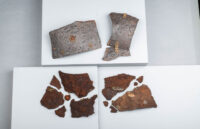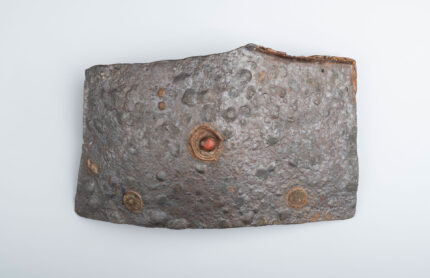Skip to comments.
Oldest Roman body armour found in Germany
The History Blog ^
| September, 2020
Posted on 10/24/2020 2:34:48 PM PDT by LibWhacker
Oldest Roman body armour found in Germany
 Archaeologists have discovered the oldest and most complete Roman body armour at the site of the Battle of the Teutoburg Forest in Kalkriese, Germany. Before this find, the earliest known examples of Roman lorica segmentata — iron plate sections tied together — were found in Corbridge, UK, and date to the 2nd century. Those were fragments. The Kalkriese armor is a complete set, and includes an extremely rare iron collar used to shackle prisoners.
Archaeologists have discovered the oldest and most complete Roman body armour at the site of the Battle of the Teutoburg Forest in Kalkriese, Germany. Before this find, the earliest known examples of Roman lorica segmentata — iron plate sections tied together — were found in Corbridge, UK, and date to the 2nd century. Those were fragments. The Kalkriese armor is a complete set, and includes an extremely rare iron collar used to shackle prisoners.
More than 7,000 objects have been found at the Kalkriese battlefield site, from weapons to coins to items of everyday use. In the summer of 2018, a metal detector scan of the side wall of an excavation trench retuned 10 strong signals, indications of a large quantity of metal inside the bank. To ensure whatever was in there wasn’t exposed to the air and rapid oxidization, archaeologists removed the entire soil block containing the mystery metallics.
The first step was to scan the block to see what was inside and map out its excavation. The block was too big for regular X-ray machines, so they transported the crate to the Münster Osnabrück International Airport where the customs office has a freight-sized X-ray machine. All they could see was nails of the wooden crate and a large black hole in the shape of the soil block.
In 2019, it was sent to the Fraunhofer Institute in Fürth which has the world’s largest CT scanner — a circular platform more than 11 feet in diameter that rotates while the X-ray apparatus moves up and down — more than big enough for the crate to fit and powerful enough to see inside the dense soil block. The scan revealed the remains of a cuirass — the section of a lorica segmentata where the breastplate and back plate are buckled together. The plates of the armour were pushed together like an accordion by the weight of the soil pressing on down them for 2,000 years.
Here’s a nifty digital animation by the Fraunhofer Institute generated from the CT scan data that reveals the armour inside the soil block.
 Armed with the detailed scans, restorers were able to begin excavation of the soil block. They found that despite Kalkriese’s highly acidic sandy soil, the armour is relatively well-preserved. There is extensive corrosion of the mental, but the set is uniquely complete with hinges, buckles, bronze bosses and even extremely rare surviving pieces of the leather ties. The plates from the shoulder and chest have been recovered and restored. The belly plates are still in the soil block. There are no arm plates in this early design.
Armed with the detailed scans, restorers were able to begin excavation of the soil block. They found that despite Kalkriese’s highly acidic sandy soil, the armour is relatively well-preserved. There is extensive corrosion of the mental, but the set is uniquely complete with hinges, buckles, bronze bosses and even extremely rare surviving pieces of the leather ties. The plates from the shoulder and chest have been recovered and restored. The belly plates are still in the soil block. There are no arm plates in this early design.
 Iron plate armour was introduced by Augustus as an improvement on chain mail. It was relatively light (around 17 pounds) and because the plates were tied together with leather cords, they were much more flexible than chain mail. so it was the latest and greatest technology in 9 A.D. when Publius Quinctilius Varus blundered into a German ambush that obliterated three full Roman legions plus their auxiliaries.
Iron plate armour was introduced by Augustus as an improvement on chain mail. It was relatively light (around 17 pounds) and because the plates were tied together with leather cords, they were much more flexible than chain mail. so it was the latest and greatest technology in 9 A.D. when Publius Quinctilius Varus blundered into a German ambush that obliterated three full Roman legions plus their auxiliaries.
The legionary who wore this armour apparently survived the battle because around his neck/shoulder area was a shrew’s fiddle, also known as a neck violin. This was an iron collar connected to two handcuffs that locked a prisoner’s hands in front of his neck. The Romans used them to shackle prisoners destined for slavery. This time the tables were turned, and the soldier died in shackles.
The restoration is ongoing and is expected to take another two years. Once it’s complete, the armour will go on display in an exhibition at the Kalkriese Museum and Park.

TOPICS: History; Military/Veterans; Science
KEYWORDS: armor; germany; godsgravesglyphs; kalkriese; oldest; romanbaltic; romanempire; romangermany; rome; teutoberg; teutobergforest; teutoburg
Navigation: use the links below to view more comments.
first previous 1-20, 21-40, 41-50 next last
To: LibWhacker
Interesting how 150 years can cause people to look at the Battle of the Teutoburg Forest in a completely different light.
Back in 1851 a book by Creasy on “The Fifteen Decisive Battles of the World: from Marathon to Waterloo” states,
“that victory secured at once and forever the independence of the Teutonic race.”
Which eventually brought about the rise of the great Kings, German composers and writers and Statesmen of the that time-1800s.
Not long ago I read another essay on the battle about how if the Romans had kept their hold on Germany it would have infused the Germans with Roman Law and philosophy, and as a result there would have been no Hitler.
To: \/\/ayne
22
posted on
10/24/2020 3:29:53 PM PDT
by
wally_bert
(I cannot be sure for certain, but in my personal opinion I am certain that I am not sure.)
To: LibWhacker
No, if he was wounded, you just finish him off. No Geneva (Lat. Genava) Convention back then.
To: Husker24
Heavily regulated, I’m afraid. Even worse than here. I used to take my metal detector almost anywhere, without worry. Now, you’ve got to make sure you’ve got everyone’s permission: property owner (always required, of course), city, state, county, feds.
And God forbid if you’re caught detecting a historical site. Fines, even jail. And your pride-and-joy detector is sure to be confiscated. I quit going out almost 20 years ago.
Oh, and did I mention, Europe is much worse? Shame on you if you dig up a brass button that’s so heavily encrusted and corroded you can hardly tell it from a clod. It’s an invaluable historical treasure to some weenie at a university somewhere who specializes in clods, doncha know?
To: UnbelievingScumOnTheOtherSide
The Geneva Convention has nothing to do with it. Sometimes there are good reasons to keep prisoners alive, if only briefly.
To: LibWhacker
This was an iron collar connected to two handcuffs that locked a prisoner’s hands in front of his neck. The Romans used them to shackle prisoners destined for slavery. The Legions at the Teutonburg Forest had no use for the iron collars. I guess that the Barbarians knew what to do with them.
To: LibWhacker; SunkenCiv
To: LibWhacker; centurion316; katana; UnbelievingScumOnTheOtherSide
I’m just trying to imagine the scene here... just one scenario that may or may not have anything to do with reality...Here's another possibility - what if he was a prisoner of the Romans, rather than the Germans? Perhaps an insubordinate or panic-stricken officer; the fighting occurred over a period of days, and discipline may have begun to fail at some point...
28
posted on
10/24/2020 4:35:34 PM PDT
by
Who is John Galt?
('Urban Dictionary' - a website of the urban dicks, by the urban dicks, and for the urban dicks.)
To: LibWhacker
I’d say some steel wool and some good buffing compound and it will be like new in no time
To: LibWhacker
There is plenty of juicy territory in Eastern Europe that ill be is much less regulated.
30
posted on
10/24/2020 4:45:27 PM PDT
by
Husker24
To: katana
Dagger through the eye socket I see your point, nyuk, nyuk.
No, seriously, very plausible, thank you.
To: Husker24
Ahhh, very juicy. Maybe even more so than Western Europe.
To: Ruy Dias de Bivar
“VARUS! GIVE ME BACK MY LEGIONS!”-AugustusBeat me to it. Always glad to hear of another Roman history buff.
33
posted on
10/24/2020 5:56:11 PM PDT
by
sima_yi
( Reporting live from the far North)
To: Who is John Galt?
It could have been space aliens.
To: LibWhacker
So... just go through and quickly shackle all the enemy, dead or alive.They were a rough bunch - probably just slit their throats and moved on.
35
posted on
10/24/2020 6:50:27 PM PDT
by
Oatka
To: centurion316
It could have been space aliens. And it could have been an American police department - lefties claim they kill prisoners all the time, just for fun, especially on Saturdays...
/s
36
posted on
10/24/2020 7:09:49 PM PDT
by
Who is John Galt?
(Mit Pulver und Blei, die Gedanken sind frei... ;^)
To: Ruy Dias de Bivar
*Publius Quinctilius Varus blundered into a German ambush
Arminius (the Barbarian leader) was an ex-roman legionnaire and as such would have been intimately familiar with the layout of legionnaire encampments. I suspect it was a night slaughter by vastly outnumbered Germanic natives who took advantage of the overconfident, sleeping Roman invaders.
To: LibWhacker; Ezekiel
When they wanted to, those Romans could do some pretty nifty metal work.

Ear ring can be found in the MFA, Boston. [C. 350 to 325 B.C.],
38
posted on
10/24/2020 8:38:52 PM PDT
by
Daffynition
(*Mega Dittoes and Mega Prayers* & :))
To: thesearethetimes...; Tennessee Nana; StayAt HomeMother; Ernest_at_the_Beach; 1ofmanyfree; ...
Thanks for the pings!

39
posted on
10/24/2020 10:20:54 PM PDT
by
SunkenCiv
(Imagine an imaginary menagerie manager imagining managing an imaginary menagerie.)
To: LibWhacker
I love the format. What a presentation.
40
posted on
10/24/2020 10:26:11 PM PDT
by
CJ Wolf
(#wwg1wga #Godwins - What is scarier than offensive words? Not being able to say them..)
Navigation: use the links below to view more comments.
first previous 1-20, 21-40, 41-50 next last
Disclaimer:
Opinions posted on Free Republic are those of the individual
posters and do not necessarily represent the opinion of Free Republic or its
management. All materials posted herein are protected by copyright law and the
exemption for fair use of copyrighted works.
FreeRepublic.com is powered by software copyright 2000-2008 John Robinson
 Archaeologists have discovered the oldest and most complete Roman body armour at the site of the Battle of the Teutoburg Forest in Kalkriese, Germany. Before this find, the earliest known examples of Roman lorica segmentata — iron plate sections tied together — were found in Corbridge, UK, and date to the 2nd century. Those were fragments. The Kalkriese armor is a complete set, and includes an extremely rare iron collar used to shackle prisoners.
Archaeologists have discovered the oldest and most complete Roman body armour at the site of the Battle of the Teutoburg Forest in Kalkriese, Germany. Before this find, the earliest known examples of Roman lorica segmentata — iron plate sections tied together — were found in Corbridge, UK, and date to the 2nd century. Those were fragments. The Kalkriese armor is a complete set, and includes an extremely rare iron collar used to shackle prisoners.


